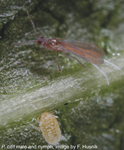
Obligate dependence does not preclude changing partners in a Russian dolls symbiotic system

Repeated replacements of an intrabacterial symbiont in the tripartite nested mealybug symbiosis
Abstract
Jousselin, E. and Vavre, F. (2017) Obligate dependence does not preclude changing partners in a Russian dolls symbiotic system. Peer Community in Evolutionary Biology, 100002. https://doi.org/10.24072/pci.evolbiol.100002
Recommendation
Symbiotic associations with bacterial partners have facilitated important evolutionary transitions in the life histories of eukaryotes. For instance, many insects have established long-term interactions with intracellular bacteria that provide them with essential nutrients lacking in their diet. However, despite the high level of interdependency among organisms involved in endosymbiotic systems, examples of symbiont replacements along the evolutionary history of insect hosts are numerous.
In their paper, Husnik and McCutcheon [1] test the stability of symbiotic systems in a particularly imbricated Russian-doll type interaction, where one bacterium lives insides another bacterium, which itself lives inside insect cells. For their study, they chose representative species of mealybugs (Pseudococcidae), a species rich group of sap-feeding insects that hosts diverse and complex symbiotic systems. In species of the subfamily Pseudococcinae, data published so far suggest that the primary symbiont, a ß-proteobacterium named Tremblaya princeps, is supplemented by a second bacterial symbiont (a ϒ-proteobaterium) that lives within its cytoplasm; both participate to the metabolic pathways that provide essential amino acids and vitamins to their hosts. Here, Husnik and McCutcheon generate host and endosymbiont genome data for five phylogenetically divergent species of Pseudococcinae in order to better understand: 1) the evolutionary history of the symbiotic associations; 2) the metabolic roles of each partner, 3) the timing and origin of Horizontal Gene Transfers (HGT) between the hosts and their symbionts.
Their results show that all species harbour the primary and at least one secondary symbiont, whose intra-bacterial localization was verified using fluorescence in situ hybridization. In one species (Pseudococcus longispinus), Tremblaya even hosts two intracellular bacteria each with a large genome (even though it is not entirely clear whether these two symbionts are indeed found within Tremblaya). The obligate presence of an intra-bacterial symbiont is best explained by the loss in Tremblaya princeps of critical genes for translation that require “intracellular complementation”.
The most striking result concerns the identity of the intra-bacterial symbiont: genome sizes and structures of the “secondary” (intra-Tremblaya) symbionts vary drastically according to the host species. Phylogenetic analyses based on 80 conserved proteins, place all these ϒ-proteoacteria (except one of the P. longispinus symbionts) in a Sodalis allied clade. However, their relationships do not mirror the one of their hosts, and some of them show signs of very recent acquisition. Altogether these results provide strong evidence for several independent acquisitions of these highly intra-bacterial integrated symbionts. Scenarios for the history of the symbiosis are clearly laid out and discussed by the authors, and the scenario involving several independent replacements of a the intra-Tremblaya symbiont by diverse Sodalis-like bacteria appears the most likely given the data presented here.
Selected biosynthetic functions are then mapped onto the host and symbiont genomes, showing the high level of interdependency of the partners for the synthesis of essential amino acids and vitamin. These maps also identify genes in the host genome that might have been acquired through HGT from bacteria and show that many of them are shared by all mealybug species sequenced so far. HGT events have thus predated the acquisitions of the current “intra-Tremblaya“ symbionts and have probably been acquired from previous symbiont infections.
Overall, this is a thorough study, using a diverse set of data and meticulous analyses that present convincing evidence that replacements of symbionts occurred repeatedly even in an imbricated symbiotic system. The phylogenetic analyses inferring the timing of HGTs also depict a highly dynamic history of gene losses and retentions in both host and symbiont genomes. Altogether these results demonstrate how the chimeric nature of individuals allows shuffling at different levels of organisation: organisms like symbionts can be replaced, genes can be exchanged among the partners of the chimera. The surprise is that constraints arising from interdependencies do not impede these exchanges. In the discussion, the authors present a very interesting parallel with the evolution of organelles: if the story presented here mirrors the one of mitochondria, it supports a gradualist view where mitochondria arrived late in the evolution of eukaryotic cells that already contained many bacterial genes resulting from HGT from previous symbionts.
Reference
[1] Husnik F., McCutcheon JP. 2016. Repeated replacements of an intrabacterial symbiont in the tripartite nested mealybug symbiosis. PNAS 113: E5416-E5424. doi: 10.1073/pnas.1603910113










